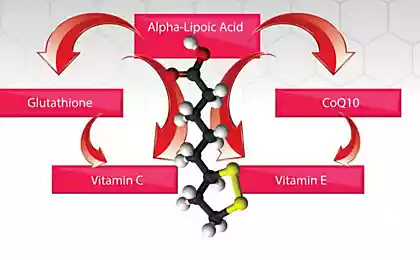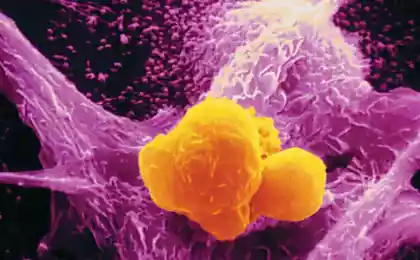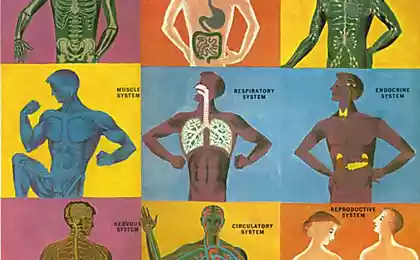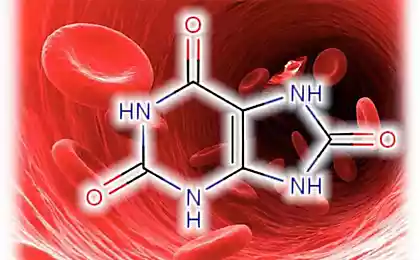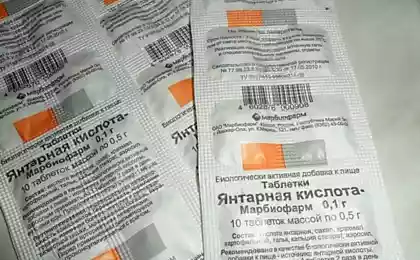722
Ray Pete: Fatigue, aging and recovery
In contrast to the rather technical medical concept of "stress» the idea of fatigue is clear to almost everyone. Studies of stress conducted by Hans Selye, was taken only 40 years after publication. And the most important work concerning the phenomenon of fatigue, and to this day hardly known, although it has been many years after they came out.
Some considerations prevented the development of, for example, the widely held view that the phenomenon of fatigue is quite understandable and to a certain extent is trivial when compared with such problems as growth, reproduction and disease.
Ten million four hundred twenty two
Fatigue is often described as a reduction reaction in the result of a surge. As an example, result in a decrease in muscle strength or speed of contraction of the muscles, reduced nerve conduction or the reduction of sensitivity of the sensory organ or its distinguishing ability. Another value of fatigue, the reduced resistance or strength, refers to the materials, and some biological functions, when, for example, fatigue leads to nausea or infections.
"Response" implies the existence of sensitivities. In his tired senses, nerves, muscles, and many other types of cells — immune cells of the excretory system, etc. — see the loss of sensitivity to the stimulus. Even in plant cells, similar processes of excitability can be reduced by repetition of the stimulus.
In a series of lectures delivered at the Royal society in England, 1895-1901., physicist Jagadish Chandra Bose reported the results of their work, which at first delighted and then worried many physicists and biologists. He invented the device that created and recorded the electromagnetic waves. He was the first who received millimeter-wave (microwave). Signal detector the Bosch was used in the first transatlantic radio transmission by Marconi. The principle of this device lies in the fact that in electric or electromagnetic field of metals in contact stick together. And to separate them by mechanical impact.
When Bose was experimenting with his "a self-restoring coherer", the semiconductor device does not need mechanical shaking, he found that after prolonged use, the instrument loses sensitivity, that is, loses its own samovosstanovleniya ability. But after some rest period is once again becoming operational. Bosch noticed that the behavior of the coherer is very similar to a electric physiology of living cells.
Then he began to experiment with plants, animals, minerals that are discovered the same response to a variety of excitations, including mechanical, thermal, and electromagnetic.
The idea of fatigue of metals was not new, but Bosch thought much deeper than the Steelworkers.
Twelve million seven hundred thousand sixty four
Biologists believed that the response to electrical pulses is the main sign of life, and Boucher has shown that not only plants, like animals, react to electric impulses, but also minerals.
There were several reasons why the Europeans and the Americans refused to accept the universality of the nature of electric properties, which they studied in animals. One of the reasons is the desire to prove that life is something intangible, and its nature has nothing in common with inorganic matter. The second problem was linked to the growing belief that the special properties of the living are enclosed in the genetic substance of every cell, and the electric cell mechanisms occur only due to the cell membranes that surround the water droplet with randomly moving dissolved chemicals. From the position of the membrane electrical theory was important to believe in random behavior of everything dissolved in the cell water.
So they were sure that the electro-mechanical reactions and interactions in the crystals have nothing to do with the processes occurring in living organisms, and therefore ruled out any analogy between them. The minerals were composed of atoms and, according to the dominant doctrine of the time, they could not be any "physiological" functions except on the atomic level. All this happened 20 years before the idea of nonlocal forces and fields in minerals is widespread in physics.
The main interest throughout a long career (1889-1941) George Krila it was the desire to understand, what a shock, biological energy and fatigue.
He believed that shock is the result of exhaustion of the brain and in one of his last works he showed that the brain is depleted of animal produced less bioluminescence compared to the brain of the animal rested. His merit is that he showed: fatigue and shock is a systemic condition of the body, and are not isolated events in the environment of the nerves and muscles. Recent studies confirm the validity of his point of view. The approach of Krylia to the prevention and reversal of shock was based on the isolation of the damaged area using a local anesthesia. Blocking nerves in damaged parts of the body such as the sciatic nerve in the leg, can save a generation (and normal cell functioning) in other parts of the body.
About 30 years earlier, in 1901, the year, Vvedenskii showed that some types of fatigue are protective by blocking the response, when intense stimulation causes no response, and the weak sometimes can cause. These changes affect the functioning of the cell in different ways. He called these processes anesthesia and parabiosis.
Until now, there were two popular "explanations" of fatigue.
The obvious problem with these explanations is that fatigue is quite independent of these metabolic changes. Another thing — these ideas do not explain the real changes that occur in the cell fatigue.
Tired cells absorb water and become heavier. In addition, they become more permeable and leak. Greater access to oxygen, they become less resistant to fatigue, and when the body is in a state of mild hypoxia, as it occurs in mountain conditions, the muscles become more hardy and strong, and the speed of nerve conduction increases.
These facts do not fit the conventional cellular model, according to which the sensitivity of the cell is determined strictly by the behavior of its "membrane". (For example, the membrane can be released from the cells, large molecules in a time when it is not damaged, and the cells swell osmotically?) These facts explains the model in which the protoplasm is considered as a special phase of matter.
Another feature of fatigue (and often aging, and stress, and illness) is that muscle relaxation is slowed down or broken.
Hypothyroidism slows down the relaxation of cardiac and skeletal muscle. F. Z. Meerson showed that as a result of stress the heart muscle is in a high concentration of calcium, followed by the breakdown of fats and proteins, and these changes continually keep the damaged heart in a state of partial contraction, the muscle becomes stiff and unable to complete the contraction reduction. Many cardiologists, when talking about cardiac stiffness, mean thickening of the muscle and fibrosis, but they are the later consequences of contractile't otredaktirovano rigidity, which was described by Meyerson.
In hypothyroidism the heart eventually becomes fibrous, but first it is simply not able to relax and fully reduced. Inability to empty with each contraction is a kind of "heart failure", but it can be quickly adjusted if you enter a thyroid hormone. Even the fibrous heart can recover under the action of adequate amounts of thyroid hormone.
The analogy with the "coherer" suggests that an overloaded muscle is unable to decoderesult yourself until you rest. She responds to stimulus, does not preclude the flow of energy, but then just unable to turn it off, so the energy flows and flows due to changes in the physical state.
One million five hundred twenty four thousand one hundred ninety seven
Albert Szent-Gyorgyi was perhaps the first person who seriously studied the semiconductor properties of living things. Because he was familiar with the idea of V. F. Koch on free radical catalyst of oxidative metabolism in 1941, the year he assumed cell proteins can function as electrical conductors (or semiconductors), and most likely he relied on his own studies of cellular respiration and muscle proteins. He observed that ATP reduces the viscosity of the solution of the muscle protein myosin, and this, in turn, causes reduced muscle myosin filament. The idea of the polymerization and the reduction of protein under the action of free radicals were Central in the therapeutic concepts V. F. Koch, but 100 years ahead of time, by medical standards.
Szent-Gyorgyi observed that, although molecules of ATP and are involved in muscle contraction, their disappearance after death causes contraction and hardening of muscles, known as rigor Mortis. When he dropped dead muscle hardened in a solution of ATP, she softened and relaxed. A relaxed state is a condition characterized by adequate energy supply.
After moving in 1947 to the USA Szent-Gyorgyi showed how muscle is affected by the cytoplasm on the behavior of fluorescent substances, which was similar to the behavior of ice, while muscle was not stimulated. In the process of contraction of the muscles of the fluorescent substance behaved as if it was in normal liquid water. This effect was associated with stabilization of the excited States of electrons. One only this demonstration was to force scientists to abandon the membrane theory of cell excitation and return to the basics of physics to use it to study cellular behavior. The work of Szent-Gyorgyi extremely important for biology and medicine, and even for the understanding of semiconductors, but the world, for the most part, just mesmerized by the textbooks model of cell membranes.
Szent-Gyorgyi also found that the combination of properly balanced amounts of the electron donors and acceptors (YES-steam) causes muscle contraction. He compared this with the "doping" of inorganic semiconductor to control its electronic properties. Although these experiments was supplied half a century later, after Koch had applied chemistry of free radicals in medicine, they are still not able to bring the industry of medicines from the state toxic sleep.
I was under the impression that the work of Szent-Gyorgyi research interesting electronic properties of cell water and proteins prompted The Linus Pauling in 1960 explanation of anesthesia in particular anesthesia with the help of noble gases in terms of the formation of water clathrates and restrukturiranja cell water hydrophobic atom or molecule is anesthetic. His suggestion caused such a reaction among biologists that 40 years reflected the willingness to engage in deeper research in this direction.
With the filing Erwin Schrödinger lYudioften think about life as a negentropy, opposing the overall growth of entropy, aging and death, considered as a manifestation of the law of increasing entropy.
A. Zotin studied living organisms, not abstractions about electrons, and showed that aging involves a decrease in entropy and a slower metabolism. Entropy decreases with aging according to his point of view, similarly to crystallization, a sort of progressive freeze.
The stimulation of the nerve is sharply releases the energy, and, it turns out, most of this heat is the result of structural changes in the cytoplasm, since (in the nerves of crustaceans, which can operate at low temperatures) during the recovery phase the temperature of the nerve descends just below the temperature of the environment, despite the fact that part of the heat is released in response to chemical changes in the metabolism that causes nervous activity.
When the physical change is endothermic, and nerve reconstruction is a process of this kind, it is possible to interpret this situation as an increase of the total entropy, as in the gum, which cools down the case of spontaneous reduction.
In the rest of the Bose coherer, which over time was restored to its solid state (i.e., relatively insulating) properties that did not receive energy through metabolism. When the particles returned to their relatively isolated state, was that there takes place disordering, perhaps similar to the spontaneous energy transitions in stimulated nerve crustaceans. I assume that these changes occurred due to absorption of heat from the environment, perhaps, by the infrared resonance with electrons of the conduction band.
If you imagine the structure of the cytoplasm as a spring mechanism, capable to oscillate between two States or "phases", it will facilitate understanding of cellular fatigue as something different from various metabolic sources of energy; ATP, glycogen and oxygen, contrary to common assumptions, are not so closely tied to functional loss that occurs during fatigue.
Thus, the role of metabolism is rather similar to the role of "Telegraph key" in the early samples of the coherer.
Thirty four million two hundred thirty five thousand nine hundred eighty nine
Water in the normal state is an insulator. But when she polarized electric charge or in the presence of phase boundaries, its state changes. This is a special interface or vicinal water. As you move ions (mainly sodium, potassium, calcium and magnesium) in the process of excitation state of the cell water necessarily changes due to the presence of different substances. In the excited state of intracellular water becomes less hydrophobic, more hydrophilic, than in a state of relaxation. A network of "hydrophobic" interactions permeates the cell during relaxation. One of the properties of the dielectric is a tendency to move into the region between the charges under the action of forces, which, in principle, similar to that operating in the process of dielectrophoresis.
At rest, the main inorganic ion is potassium, it is associated with acidic groups such as aspartic acid and glutamic acid. In the process of excitation of a potassium partially replaced by sodium that becomes the primary counterion to these acid groups, and in the cell along with the sodium goes in and calcium.
The relationship of potassium with water is very weak (it hydration considered negative) that allows water to form stable in the presence of a hydrophobic surface structure. Sodium and especially calcium (atoms of smaller size with higher surface concentration of charge) powerfully interact with the water molecules is much stronger than between water molecules, breaking a delicate and rather hydrophobic structure of the intercellular water.
(Divalent calcium has an important stabilizing link in a resting cell. Upon excitation of the cell distinguishes these internal calcium ions, and in their place inside the cell are calcium ions from the intercellular space.)
C increased movement of charged particles during the stimulation of a nerve or muscle when one of protivin is replaced by another, and destroyed some of the water structure, the dielectric volumetric water gets more opportunities to enter the cell and interact with proteins, causing swelling and separation of the structural elements of cells. Electron micrographs tired muscles show a significant spatial separation of actin and myosin.
NMR studies show that the state of excitation of the cell, water behaves more like normal, that is, movement of its molecules are relatively free, which indicates instantaneous destruction of the interfacial state. In this state the absorption of water and is associated with fatigue, swelling of the nerves and muscles will be partially on the principle of retraction of the dielectric in the space between the separated charges. Normal water that comes into the cell in the process of disintegration of the structures of vicinal water acts in this case as a foreign substance that the cell can't control.
These highly dielectric properties of bulk (ordinary, normal) of water in the excited cell state can explain many of the changes in enzymatic activity. From non-polar lipids forms a negatively charged surface (due to the accumulation of hydroxyl groups: Marinova et al., 1996), which enhances their oxidation and degradation. With the loss of interfacial water high-energy state of a cell at rest is replaced by the process of actively mobilizing its resources to preserve and restore the cellular structure. The recovery process begins to receive the metabolic energy that takes on the role of the Telegraph key in the early coherer.
Studying fatigue, muscle contraction and nerve conduction, we can check out some of the traditional model and to assess whether the newer "bio electronic" models correspond to the facts. Osmotic pressure, hydrostatic pressure, atmospheric pressure and the degree of metabolic stimulation by thyroid hormone affect the fatigue, but in a manner that does not fit in the membrane electric doctrine.
Production of lactic acid during intense muscular activity brought some experts to the idea thatfatigue occurs when the muscle loses oxygen. However, it is experimentally shown that fatigue occurs even in the case when the muscle is adequately supplied with oxygen. Divers sometimes get an excessive amount of oxygen, which often causes muscle fatigue and soreness. At high altitudes, where oxygen is relatively low, the stamina and strength can be developed.
Excess oxygen can slow down nerve conduction, hypoxia — accelerate. (Enhanced supply of oxygen under high pressure causes its increased consumption by the cell or a decrease in the production of lactic acid (Kohzuki et al, 2000), and promotes lipid peroxidation).
High hydrostatic pressure causes contraction of the muscles, although for many years membrane, the doctrine does not allow to accept this fact. Brain diver under the action of very high pressure is in the excited state. Since vicinal water has a larger volume than normal (similar to the volume change in the process of formation of ice, although the increase in cell water is somewhat less 4 % than that of ice, which is 11% more volume of water), compression under high pressure translates vicinal water in cellular status that occur in the excited cell, like the melting of ice under pressure. While the water is in this state, the stimulation of the cells is maintained.
The under pressure similar to the way Bosch used pressure in some of its coherer, and as the pressure changes the sensitivity of electrons in a semiconductor by changing the "forbidden zone" — the amount of energy that is required to move into the conduction band.
The easiest way to demonstrate that water changes its phase state in the process of muscle contraction, is to measure the volume of an isolated muscle. The stimulation and reducing the amount of muscle varies somewhat. (The muscle was completely immersed in water in a sealed container and measurements showed a decrease in the volume of the container). This corresponds to the transition of vicinal water in an ordinary (dielectric) state. (These experiments with spontaneous volume change, membrane carrying the threat doctrine was very annoyed many biologists of my generation of teachers).
In the stimulated state, the absorption of water by the cell from the surrounding space very closely coincides with its electrical and thermal activity, and the selection with the restoration. In a small nerve fiber, or near the surface of a larger fiber, these changes happen very quickly, and in a large muscle the uptake of water ahead of the rate of arrival of water from the capillaries, and if the stimulation continues for several minutes, the water absorption becomes significant. For example, a two-minute stimulation can lead to an increase in muscle weight by 6 %, while the intercellular space loses 4 %, this means that in a short interval of time the muscle gaining weight much more than 6 % (Ward et al., 1996). The water absorbed by the muscle, comes from the blood, which becomes somewhat dehydrated and viscous.
Faith in the "semi-permeable membrane" (which for a long time can not explain cell physiology) causes some people to explain cell swelling, osmotic processes, that is, it means that they just assume a significant increase in the number of dissolved particles cell in a short time. The results of the experiments Tasaki (1980, 1981, 1982) swelling of the nerve coincides with the electrical action potential, which, according to the osmotic explanation, means that a significant increase in the internal osmolarity is almost instantaneous. The action potential appears and disappears in about 2 milliseconds. The swelling also coincides with heat production and shortening the nerve fibers. The reduction in nerve fibers after attenuation of the wave of action potential can happen so fast, and membrane theory can not explain it. (A recovery neotechnology state can take a long time depending on the external conditions of each particular muscle or cells). Taken Troshin test of the theory of osmotic regulation of cell volume revealed that the performance of the cell as a membrane vapor-pressure osmometer wrongly, but few biologists have read his book.
As excited or tired muscle or nerve swell and gain weight, it is interesting to see what happens to their sensitivity and durability under the action of hypotonic solutions, which are known to contribute to edema, or hypertensive, which they oppose.
In hypotonic solution the cells are in the excited state (Lang et al., 1995: "Exposure to hypotonic extracellular fluid to the tissue of the aorta of Guinea pigs is accompanied by severe vasoconstriction..."), but the excitation should be reduced response (Ohba et al., 1984: "the Influence of hypotonic (70 % of normal) solution on muscle first causes a temporary boost in her twitching, after which it decreases to below the reference level"). Hypertonic solutions tend to cause relaxation in normal muscles, including the muscle of the aorta (Tabrizchi, 1999), but in case of violation of muscle function (especially in the circulatory system, for example, in shock) they improve contractile function (Elgjo., 1998: "the Maximum measured contractile force right papillary muscles ex vivo exposure to hypertonic saline significantly exceeded the similar parameter in the processing of normal saline"). Athletes can lose up to 4% weight by dehydration without reducing muscle strength.
Hypothyroidism causes a tendency to decrease in blood sodium, hyponatremia sometimes leads to a General lowering of the tone of organism liquids. Thyroid hormone itself acts as an antioxidant, but much of its protective properties against the cellular damage is probably the result of preventing cell swelling and rapid excretion of cellular calcium. (The swelling, as fatigue causes an increase in the concentration of extracellular calcium.)
The increase of surface electric charge of the lipids in the bulk water may occur due to increased peroxidation, which occurs when there is fatigue, edema, and hypothyroidism, when the water loses its normal partial hydrophobicity. It is known that the increase of carbon dioxide leads to decrease of lipid peroxidation, and its production requires adequate functioning of the thyroid gland.
The increased request for consumption of oxygen caused by thyroid hormone, inhibits the production of lactic acid; this keeps the cytoplasm in a state of relative oxidation, i.e., concentration of NAD+ is maintained at a level hundreds of times greater than the concentration of NADP. NADP is required for the conversion of pyruvate to lactate and is a source of lower potential to a variety of toxic redox cycles, which lead to the formation of peroxide lipids. NADP also supports the sulfhydryl system, and the balance of reduced glutathione and sulfhydryl-disulfide protein bonds system, which controls the state of the electrons of the cells and influences the hydrophobicity and the hydrophilicity.
The damaging oxidation of lipids interferes with energy production and regulation and is responsible for the consequences of long-term effects of fatigue, edema, and hypothyroidism. The lingering effects caused by the oxidation of lipids, no doubt enhanced by the presence of large amounts of unstable polyunsaturated fats, as energiapro in a state of fatigue leads to mobilization of free fatty acids from the tissues.
One of the oldest tests for hypothyroidism is the Achilles reflex, where the degree of relaxation of the calf muscle corresponds to the level of functioning of the thyroid gland — relaxation in people suffering from hypothyroidism, delayed. Hypothyroid muscle slowly releases water, sodium and calcium. Exactly the same slow relaxation occurs in the hypothyroid heart muscle, contributing to congestive heart failure because polyacetylene the heart cannot obtain sufficient blood, compared to a normal relaxed heart. Hypothyroid blood vessels cannot properly relax, resulting in increased pressure. Hypothyroid nerves with difficulty returning to a relaxed energy state, leading to insomnia, paresthesia, movement disorders, and nerves themselves become edematous and easily damaged by pressure.
In the aging process, stress, fatigue and hypothyroidism the amount of estrogen in the body usually increases. Estrogen is against the muscle is catabolic and causes systemic edema, and nervous excitement. It relaxes the muscular contractility of the bladder, though, and lowers the threshold of stimulation sensations and contractions (Dambros et al., 2004). For this reason, people often awaken, to be freed from a small amount of urine. (Progesterone has the opposite effect on the bladder, raising the reaction threshold and increasing contractility, as in the gallbladder). Estrogen lowers the threshold of stimulation in the gallbladder, as in the brain. Partly its stimulating effect may be the result of increased hypotonic cell water and its impact on verge of nervous excitability is practically instant.
Production of lactic acid growing in a state of fatigue, aging, hypothyroidism, excess estrogen and other inefficient biological conditions. The presence of lactic acid in the presence of oxygen means that something interferes with efficient oxidative metabolism. The production of ammonia, free fatty acids and various inflammatory cytokines, most likely, will grow in these stressful conditions.
Dangerous high level of ammonia in the blood (hyperammonemia) can be caused by exhausting load, as well as hyperbaric oxygen (or a high concentration of oxygen), high values of estrogen or hypothyroidism. It is usually associated with an excess of lactic acid, probably because ammonia stimulates glycolysis. An excess of oxygen, as in hypothyroidism, the equivalent of "hyperventilation" in the development abnormally low level of carbon dioxide in the blood. The Krebs cycle under stress is limited by the unavailability of carbon dioxide. These factors lead to inefficient use of glucose when it is converted to lactic acid, not carbon dioxide and energy. In this sense, the metabolism of tired muscles (and any cells under stress) is similar to the metabolism of the tumor.
The hyperammonemia disrupts the processes of excitation and can lead to seizures, to enter into a stupor and probably involved in manic and depressive States. Lithium, as it turned out, joins him at the expense of the electron shell, and I think it explains some of its therapeutic properties, but the main biological factor in the elimination of ammonia is carbon dioxide, since he unites with him for the formation of urine. Changes in the cell water in the state of arousal/fatigue lead to the growth of its "structural temperature", and this means that the excitation the smaller the amount of carbon dioxide can remain dissolved in it.
Sugar consumption and use of caffeine, which increases the oxidation of sugar (Yeo et al, 2005), can reduce fatigue, both objectively and subjectively. From the metabolic point of view, they increase the production of carbon dioxide. The growth of sugar reduces the release and uptake of fatty acids and, due to a number of mechanisms assist in reducing the production of ammonia, lactate and inflammatory cytokines. (Lactic acid in combination with acidosis and free phospholipids may disrupt the efficient execution of cellular functions [Pacini and Kane, 1991; Boachie-Ansah., 1992].) Free fatty acids release tryptophan from albumin, thus making a contribution to the formation of serotonin, which enhances the feeling of fatigue.
Aspirin and Niacin can help prevent the symptoms of fatigue and many systemic oxidative damaging effects. (Both are antipolitical; aspirin uncouples the mitochondria.)
Separation of mitochondrial oxidative metabolism and ATP production helps in the absorption of sugar, which would otherwise be converted into lactic acid, and instead turns into carbon dioxide. Moderate hypoxia (as in high altitude conditions) inhibits the production of lactic acid ("lactate paradox"), and increases the content of carbon dioxide in the tissues.
Aspirin and thyroid hormone (T3) enhance the separation. A drug that was once used for weight loss, dinitrophenol, also uncouples mitochondrial metabolism, and, strange to say, has some positive effects that are inherent to aspirin and T3. It stimulates the consumption of lactic acid and carbon dioxide.
Living in the mountains people usually eat more and remain more lean than when they live at sea level. Apparently, their mitochondria quite disjointed, and they have more mitochondria, which partly explains why they have lower lactic acid production in muscle tension. Increased activity of the thyroid gland also contributes to increasing both the mitochondrial mass and the separation of mitochondria.
A big part of what we believe, fatigue is the result of a violation of hydration of the cells, whose sensitivity, composition and structure vary depending on degree of violation. Hydration of the cells is controlled by its electrical properties, which govern internal processes — metabolic and system. When cellular fatigue reaches a certain level, a stable cell structure and function can recover only the organs with a smooth interaction. The liver eliminates lactic acid and ammonia, adrenal glands and sex glands produce stabilizing steroid, the brain adjusts activity and behaviour so as to make reversible the effects of fatigue.
However, if the tissue is a lot of polyunsaturated fats, every episode of fatigue and prolonged excitation leads to oxidative injury, resulting in the adaptation mechanism becomes less and less effective. When the most powerful adaptive mechanisms, such as timely production of progesterone, pregnenolone, DHEA, T3, inhibitory neurotransmitters, GABA and glycine are damaged, chronically activated other, more primitive defense mechanisms, and even then the sleep is unable to cope with the restoration of normal cellular hydration and metabolism. Often the problem becomes hyperventilation, exacerbated by leaking capillaries.
Water in the body concentrated in three main areas — blood vessels, extracellular matrix and in the wet substance cages and in each of these areas its status varies varies. In the US, there are no textbooks, which would set out a scientific approach in the description of the intracellular water, resulting in doctors faced with cases of edema or disorder of the blood volume, patients often get confused. The doctor rarely comes to mind to address the issue of water allocation in case of such conditions as chronic fatigue, fibromyalgia, sleep disorders, frequent urination, slow bladder emptying, anxiety, paresthesia, movement disorders, carpal tunnel syndrome and even slow thinking, although "intracellular fatigue" leading to overhydratation is likely a Central issue in these and many other degenerative and inflammatory processes.
The theme of improving cellular functioning and distribution of water, which is inversely proportional to the oxygen pressure, and directly proportional to the pressure of carbon dioxide will not enter the textbooks as long as the idea prevails on the regulation of the state of cells with membranes.
"Treatment" intracellular fatigue consists:
A simple increase in carbon dioxide reduces lactic acid and ammonia, increases GABA (improves sleep neurotransmitter) and regulates the movement of minerals and water.
The study of the physiology of fatigue leads to a better understanding of the whole cell and enables a deeper look into the processes of aging, inflammation and many stress-related diseases.published
© Ray Pete
P. S. And remember, only by changing their consumption — together we change the world! ©
Source: //ekiri22.blogspot.ru/2016/04/blog-post.html
Some considerations prevented the development of, for example, the widely held view that the phenomenon of fatigue is quite understandable and to a certain extent is trivial when compared with such problems as growth, reproduction and disease.
Ten million four hundred twenty two
Fatigue is often described as a reduction reaction in the result of a surge. As an example, result in a decrease in muscle strength or speed of contraction of the muscles, reduced nerve conduction or the reduction of sensitivity of the sensory organ or its distinguishing ability. Another value of fatigue, the reduced resistance or strength, refers to the materials, and some biological functions, when, for example, fatigue leads to nausea or infections.
"Response" implies the existence of sensitivities. In his tired senses, nerves, muscles, and many other types of cells — immune cells of the excretory system, etc. — see the loss of sensitivity to the stimulus. Even in plant cells, similar processes of excitability can be reduced by repetition of the stimulus.
In a series of lectures delivered at the Royal society in England, 1895-1901., physicist Jagadish Chandra Bose reported the results of their work, which at first delighted and then worried many physicists and biologists. He invented the device that created and recorded the electromagnetic waves. He was the first who received millimeter-wave (microwave). Signal detector the Bosch was used in the first transatlantic radio transmission by Marconi. The principle of this device lies in the fact that in electric or electromagnetic field of metals in contact stick together. And to separate them by mechanical impact.
When Bose was experimenting with his "a self-restoring coherer", the semiconductor device does not need mechanical shaking, he found that after prolonged use, the instrument loses sensitivity, that is, loses its own samovosstanovleniya ability. But after some rest period is once again becoming operational. Bosch noticed that the behavior of the coherer is very similar to a electric physiology of living cells.
Then he began to experiment with plants, animals, minerals that are discovered the same response to a variety of excitations, including mechanical, thermal, and electromagnetic.
The idea of fatigue of metals was not new, but Bosch thought much deeper than the Steelworkers.
Twelve million seven hundred thousand sixty four
Biologists believed that the response to electrical pulses is the main sign of life, and Boucher has shown that not only plants, like animals, react to electric impulses, but also minerals.
There were several reasons why the Europeans and the Americans refused to accept the universality of the nature of electric properties, which they studied in animals. One of the reasons is the desire to prove that life is something intangible, and its nature has nothing in common with inorganic matter. The second problem was linked to the growing belief that the special properties of the living are enclosed in the genetic substance of every cell, and the electric cell mechanisms occur only due to the cell membranes that surround the water droplet with randomly moving dissolved chemicals. From the position of the membrane electrical theory was important to believe in random behavior of everything dissolved in the cell water.
So they were sure that the electro-mechanical reactions and interactions in the crystals have nothing to do with the processes occurring in living organisms, and therefore ruled out any analogy between them. The minerals were composed of atoms and, according to the dominant doctrine of the time, they could not be any "physiological" functions except on the atomic level. All this happened 20 years before the idea of nonlocal forces and fields in minerals is widespread in physics.
The main interest throughout a long career (1889-1941) George Krila it was the desire to understand, what a shock, biological energy and fatigue.
He believed that shock is the result of exhaustion of the brain and in one of his last works he showed that the brain is depleted of animal produced less bioluminescence compared to the brain of the animal rested. His merit is that he showed: fatigue and shock is a systemic condition of the body, and are not isolated events in the environment of the nerves and muscles. Recent studies confirm the validity of his point of view. The approach of Krylia to the prevention and reversal of shock was based on the isolation of the damaged area using a local anesthesia. Blocking nerves in damaged parts of the body such as the sciatic nerve in the leg, can save a generation (and normal cell functioning) in other parts of the body.
About 30 years earlier, in 1901, the year, Vvedenskii showed that some types of fatigue are protective by blocking the response, when intense stimulation causes no response, and the weak sometimes can cause. These changes affect the functioning of the cell in different ways. He called these processes anesthesia and parabiosis.
Until now, there were two popular "explanations" of fatigue.
- The first explanation: fatigue occurs when a cell has expended energy (usually I think that it is ATP or glycogen).
- Second: accumulation of metabolic products (usually lactic acid) prevents further operation of.
The obvious problem with these explanations is that fatigue is quite independent of these metabolic changes. Another thing — these ideas do not explain the real changes that occur in the cell fatigue.
Tired cells absorb water and become heavier. In addition, they become more permeable and leak. Greater access to oxygen, they become less resistant to fatigue, and when the body is in a state of mild hypoxia, as it occurs in mountain conditions, the muscles become more hardy and strong, and the speed of nerve conduction increases.
These facts do not fit the conventional cellular model, according to which the sensitivity of the cell is determined strictly by the behavior of its "membrane". (For example, the membrane can be released from the cells, large molecules in a time when it is not damaged, and the cells swell osmotically?) These facts explains the model in which the protoplasm is considered as a special phase of matter.
Another feature of fatigue (and often aging, and stress, and illness) is that muscle relaxation is slowed down or broken.
Hypothyroidism slows down the relaxation of cardiac and skeletal muscle. F. Z. Meerson showed that as a result of stress the heart muscle is in a high concentration of calcium, followed by the breakdown of fats and proteins, and these changes continually keep the damaged heart in a state of partial contraction, the muscle becomes stiff and unable to complete the contraction reduction. Many cardiologists, when talking about cardiac stiffness, mean thickening of the muscle and fibrosis, but they are the later consequences of contractile't otredaktirovano rigidity, which was described by Meyerson.
In hypothyroidism the heart eventually becomes fibrous, but first it is simply not able to relax and fully reduced. Inability to empty with each contraction is a kind of "heart failure", but it can be quickly adjusted if you enter a thyroid hormone. Even the fibrous heart can recover under the action of adequate amounts of thyroid hormone.
The analogy with the "coherer" suggests that an overloaded muscle is unable to decoderesult yourself until you rest. She responds to stimulus, does not preclude the flow of energy, but then just unable to turn it off, so the energy flows and flows due to changes in the physical state.
One million five hundred twenty four thousand one hundred ninety seven
Albert Szent-Gyorgyi was perhaps the first person who seriously studied the semiconductor properties of living things. Because he was familiar with the idea of V. F. Koch on free radical catalyst of oxidative metabolism in 1941, the year he assumed cell proteins can function as electrical conductors (or semiconductors), and most likely he relied on his own studies of cellular respiration and muscle proteins. He observed that ATP reduces the viscosity of the solution of the muscle protein myosin, and this, in turn, causes reduced muscle myosin filament. The idea of the polymerization and the reduction of protein under the action of free radicals were Central in the therapeutic concepts V. F. Koch, but 100 years ahead of time, by medical standards.
Szent-Gyorgyi observed that, although molecules of ATP and are involved in muscle contraction, their disappearance after death causes contraction and hardening of muscles, known as rigor Mortis. When he dropped dead muscle hardened in a solution of ATP, she softened and relaxed. A relaxed state is a condition characterized by adequate energy supply.
After moving in 1947 to the USA Szent-Gyorgyi showed how muscle is affected by the cytoplasm on the behavior of fluorescent substances, which was similar to the behavior of ice, while muscle was not stimulated. In the process of contraction of the muscles of the fluorescent substance behaved as if it was in normal liquid water. This effect was associated with stabilization of the excited States of electrons. One only this demonstration was to force scientists to abandon the membrane theory of cell excitation and return to the basics of physics to use it to study cellular behavior. The work of Szent-Gyorgyi extremely important for biology and medicine, and even for the understanding of semiconductors, but the world, for the most part, just mesmerized by the textbooks model of cell membranes.
Szent-Gyorgyi also found that the combination of properly balanced amounts of the electron donors and acceptors (YES-steam) causes muscle contraction. He compared this with the "doping" of inorganic semiconductor to control its electronic properties. Although these experiments was supplied half a century later, after Koch had applied chemistry of free radicals in medicine, they are still not able to bring the industry of medicines from the state toxic sleep.
I was under the impression that the work of Szent-Gyorgyi research interesting electronic properties of cell water and proteins prompted The Linus Pauling in 1960 explanation of anesthesia in particular anesthesia with the help of noble gases in terms of the formation of water clathrates and restrukturiranja cell water hydrophobic atom or molecule is anesthetic. His suggestion caused such a reaction among biologists that 40 years reflected the willingness to engage in deeper research in this direction.
With the filing Erwin Schrödinger lYudioften think about life as a negentropy, opposing the overall growth of entropy, aging and death, considered as a manifestation of the law of increasing entropy.
A. Zotin studied living organisms, not abstractions about electrons, and showed that aging involves a decrease in entropy and a slower metabolism. Entropy decreases with aging according to his point of view, similarly to crystallization, a sort of progressive freeze.
The stimulation of the nerve is sharply releases the energy, and, it turns out, most of this heat is the result of structural changes in the cytoplasm, since (in the nerves of crustaceans, which can operate at low temperatures) during the recovery phase the temperature of the nerve descends just below the temperature of the environment, despite the fact that part of the heat is released in response to chemical changes in the metabolism that causes nervous activity.
When the physical change is endothermic, and nerve reconstruction is a process of this kind, it is possible to interpret this situation as an increase of the total entropy, as in the gum, which cools down the case of spontaneous reduction.
In the rest of the Bose coherer, which over time was restored to its solid state (i.e., relatively insulating) properties that did not receive energy through metabolism. When the particles returned to their relatively isolated state, was that there takes place disordering, perhaps similar to the spontaneous energy transitions in stimulated nerve crustaceans. I assume that these changes occurred due to absorption of heat from the environment, perhaps, by the infrared resonance with electrons of the conduction band.
If you imagine the structure of the cytoplasm as a spring mechanism, capable to oscillate between two States or "phases", it will facilitate understanding of cellular fatigue as something different from various metabolic sources of energy; ATP, glycogen and oxygen, contrary to common assumptions, are not so closely tied to functional loss that occurs during fatigue.
Thus, the role of metabolism is rather similar to the role of "Telegraph key" in the early samples of the coherer.
Thirty four million two hundred thirty five thousand nine hundred eighty nine
Water in the normal state is an insulator. But when she polarized electric charge or in the presence of phase boundaries, its state changes. This is a special interface or vicinal water. As you move ions (mainly sodium, potassium, calcium and magnesium) in the process of excitation state of the cell water necessarily changes due to the presence of different substances. In the excited state of intracellular water becomes less hydrophobic, more hydrophilic, than in a state of relaxation. A network of "hydrophobic" interactions permeates the cell during relaxation. One of the properties of the dielectric is a tendency to move into the region between the charges under the action of forces, which, in principle, similar to that operating in the process of dielectrophoresis.
At rest, the main inorganic ion is potassium, it is associated with acidic groups such as aspartic acid and glutamic acid. In the process of excitation of a potassium partially replaced by sodium that becomes the primary counterion to these acid groups, and in the cell along with the sodium goes in and calcium.
The relationship of potassium with water is very weak (it hydration considered negative) that allows water to form stable in the presence of a hydrophobic surface structure. Sodium and especially calcium (atoms of smaller size with higher surface concentration of charge) powerfully interact with the water molecules is much stronger than between water molecules, breaking a delicate and rather hydrophobic structure of the intercellular water.
(Divalent calcium has an important stabilizing link in a resting cell. Upon excitation of the cell distinguishes these internal calcium ions, and in their place inside the cell are calcium ions from the intercellular space.)
C increased movement of charged particles during the stimulation of a nerve or muscle when one of protivin is replaced by another, and destroyed some of the water structure, the dielectric volumetric water gets more opportunities to enter the cell and interact with proteins, causing swelling and separation of the structural elements of cells. Electron micrographs tired muscles show a significant spatial separation of actin and myosin.
NMR studies show that the state of excitation of the cell, water behaves more like normal, that is, movement of its molecules are relatively free, which indicates instantaneous destruction of the interfacial state. In this state the absorption of water and is associated with fatigue, swelling of the nerves and muscles will be partially on the principle of retraction of the dielectric in the space between the separated charges. Normal water that comes into the cell in the process of disintegration of the structures of vicinal water acts in this case as a foreign substance that the cell can't control.
These highly dielectric properties of bulk (ordinary, normal) of water in the excited cell state can explain many of the changes in enzymatic activity. From non-polar lipids forms a negatively charged surface (due to the accumulation of hydroxyl groups: Marinova et al., 1996), which enhances their oxidation and degradation. With the loss of interfacial water high-energy state of a cell at rest is replaced by the process of actively mobilizing its resources to preserve and restore the cellular structure. The recovery process begins to receive the metabolic energy that takes on the role of the Telegraph key in the early coherer.
Studying fatigue, muscle contraction and nerve conduction, we can check out some of the traditional model and to assess whether the newer "bio electronic" models correspond to the facts. Osmotic pressure, hydrostatic pressure, atmospheric pressure and the degree of metabolic stimulation by thyroid hormone affect the fatigue, but in a manner that does not fit in the membrane electric doctrine.
Production of lactic acid during intense muscular activity brought some experts to the idea thatfatigue occurs when the muscle loses oxygen. However, it is experimentally shown that fatigue occurs even in the case when the muscle is adequately supplied with oxygen. Divers sometimes get an excessive amount of oxygen, which often causes muscle fatigue and soreness. At high altitudes, where oxygen is relatively low, the stamina and strength can be developed.
Excess oxygen can slow down nerve conduction, hypoxia — accelerate. (Enhanced supply of oxygen under high pressure causes its increased consumption by the cell or a decrease in the production of lactic acid (Kohzuki et al, 2000), and promotes lipid peroxidation).
High hydrostatic pressure causes contraction of the muscles, although for many years membrane, the doctrine does not allow to accept this fact. Brain diver under the action of very high pressure is in the excited state. Since vicinal water has a larger volume than normal (similar to the volume change in the process of formation of ice, although the increase in cell water is somewhat less 4 % than that of ice, which is 11% more volume of water), compression under high pressure translates vicinal water in cellular status that occur in the excited cell, like the melting of ice under pressure. While the water is in this state, the stimulation of the cells is maintained.
The under pressure similar to the way Bosch used pressure in some of its coherer, and as the pressure changes the sensitivity of electrons in a semiconductor by changing the "forbidden zone" — the amount of energy that is required to move into the conduction band.
The easiest way to demonstrate that water changes its phase state in the process of muscle contraction, is to measure the volume of an isolated muscle. The stimulation and reducing the amount of muscle varies somewhat. (The muscle was completely immersed in water in a sealed container and measurements showed a decrease in the volume of the container). This corresponds to the transition of vicinal water in an ordinary (dielectric) state. (These experiments with spontaneous volume change, membrane carrying the threat doctrine was very annoyed many biologists of my generation of teachers).
In the stimulated state, the absorption of water by the cell from the surrounding space very closely coincides with its electrical and thermal activity, and the selection with the restoration. In a small nerve fiber, or near the surface of a larger fiber, these changes happen very quickly, and in a large muscle the uptake of water ahead of the rate of arrival of water from the capillaries, and if the stimulation continues for several minutes, the water absorption becomes significant. For example, a two-minute stimulation can lead to an increase in muscle weight by 6 %, while the intercellular space loses 4 %, this means that in a short interval of time the muscle gaining weight much more than 6 % (Ward et al., 1996). The water absorbed by the muscle, comes from the blood, which becomes somewhat dehydrated and viscous.
Faith in the "semi-permeable membrane" (which for a long time can not explain cell physiology) causes some people to explain cell swelling, osmotic processes, that is, it means that they just assume a significant increase in the number of dissolved particles cell in a short time. The results of the experiments Tasaki (1980, 1981, 1982) swelling of the nerve coincides with the electrical action potential, which, according to the osmotic explanation, means that a significant increase in the internal osmolarity is almost instantaneous. The action potential appears and disappears in about 2 milliseconds. The swelling also coincides with heat production and shortening the nerve fibers. The reduction in nerve fibers after attenuation of the wave of action potential can happen so fast, and membrane theory can not explain it. (A recovery neotechnology state can take a long time depending on the external conditions of each particular muscle or cells). Taken Troshin test of the theory of osmotic regulation of cell volume revealed that the performance of the cell as a membrane vapor-pressure osmometer wrongly, but few biologists have read his book.
As excited or tired muscle or nerve swell and gain weight, it is interesting to see what happens to their sensitivity and durability under the action of hypotonic solutions, which are known to contribute to edema, or hypertensive, which they oppose.
In hypotonic solution the cells are in the excited state (Lang et al., 1995: "Exposure to hypotonic extracellular fluid to the tissue of the aorta of Guinea pigs is accompanied by severe vasoconstriction..."), but the excitation should be reduced response (Ohba et al., 1984: "the Influence of hypotonic (70 % of normal) solution on muscle first causes a temporary boost in her twitching, after which it decreases to below the reference level"). Hypertonic solutions tend to cause relaxation in normal muscles, including the muscle of the aorta (Tabrizchi, 1999), but in case of violation of muscle function (especially in the circulatory system, for example, in shock) they improve contractile function (Elgjo., 1998: "the Maximum measured contractile force right papillary muscles ex vivo exposure to hypertonic saline significantly exceeded the similar parameter in the processing of normal saline"). Athletes can lose up to 4% weight by dehydration without reducing muscle strength.
Hypothyroidism causes a tendency to decrease in blood sodium, hyponatremia sometimes leads to a General lowering of the tone of organism liquids. Thyroid hormone itself acts as an antioxidant, but much of its protective properties against the cellular damage is probably the result of preventing cell swelling and rapid excretion of cellular calcium. (The swelling, as fatigue causes an increase in the concentration of extracellular calcium.)
The increase of surface electric charge of the lipids in the bulk water may occur due to increased peroxidation, which occurs when there is fatigue, edema, and hypothyroidism, when the water loses its normal partial hydrophobicity. It is known that the increase of carbon dioxide leads to decrease of lipid peroxidation, and its production requires adequate functioning of the thyroid gland.
The increased request for consumption of oxygen caused by thyroid hormone, inhibits the production of lactic acid; this keeps the cytoplasm in a state of relative oxidation, i.e., concentration of NAD+ is maintained at a level hundreds of times greater than the concentration of NADP. NADP is required for the conversion of pyruvate to lactate and is a source of lower potential to a variety of toxic redox cycles, which lead to the formation of peroxide lipids. NADP also supports the sulfhydryl system, and the balance of reduced glutathione and sulfhydryl-disulfide protein bonds system, which controls the state of the electrons of the cells and influences the hydrophobicity and the hydrophilicity.
The damaging oxidation of lipids interferes with energy production and regulation and is responsible for the consequences of long-term effects of fatigue, edema, and hypothyroidism. The lingering effects caused by the oxidation of lipids, no doubt enhanced by the presence of large amounts of unstable polyunsaturated fats, as energiapro in a state of fatigue leads to mobilization of free fatty acids from the tissues.
One of the oldest tests for hypothyroidism is the Achilles reflex, where the degree of relaxation of the calf muscle corresponds to the level of functioning of the thyroid gland — relaxation in people suffering from hypothyroidism, delayed. Hypothyroid muscle slowly releases water, sodium and calcium. Exactly the same slow relaxation occurs in the hypothyroid heart muscle, contributing to congestive heart failure because polyacetylene the heart cannot obtain sufficient blood, compared to a normal relaxed heart. Hypothyroid blood vessels cannot properly relax, resulting in increased pressure. Hypothyroid nerves with difficulty returning to a relaxed energy state, leading to insomnia, paresthesia, movement disorders, and nerves themselves become edematous and easily damaged by pressure.
In the aging process, stress, fatigue and hypothyroidism the amount of estrogen in the body usually increases. Estrogen is against the muscle is catabolic and causes systemic edema, and nervous excitement. It relaxes the muscular contractility of the bladder, though, and lowers the threshold of stimulation sensations and contractions (Dambros et al., 2004). For this reason, people often awaken, to be freed from a small amount of urine. (Progesterone has the opposite effect on the bladder, raising the reaction threshold and increasing contractility, as in the gallbladder). Estrogen lowers the threshold of stimulation in the gallbladder, as in the brain. Partly its stimulating effect may be the result of increased hypotonic cell water and its impact on verge of nervous excitability is practically instant.
Production of lactic acid growing in a state of fatigue, aging, hypothyroidism, excess estrogen and other inefficient biological conditions. The presence of lactic acid in the presence of oxygen means that something interferes with efficient oxidative metabolism. The production of ammonia, free fatty acids and various inflammatory cytokines, most likely, will grow in these stressful conditions.
Dangerous high level of ammonia in the blood (hyperammonemia) can be caused by exhausting load, as well as hyperbaric oxygen (or a high concentration of oxygen), high values of estrogen or hypothyroidism. It is usually associated with an excess of lactic acid, probably because ammonia stimulates glycolysis. An excess of oxygen, as in hypothyroidism, the equivalent of "hyperventilation" in the development abnormally low level of carbon dioxide in the blood. The Krebs cycle under stress is limited by the unavailability of carbon dioxide. These factors lead to inefficient use of glucose when it is converted to lactic acid, not carbon dioxide and energy. In this sense, the metabolism of tired muscles (and any cells under stress) is similar to the metabolism of the tumor.
The hyperammonemia disrupts the processes of excitation and can lead to seizures, to enter into a stupor and probably involved in manic and depressive States. Lithium, as it turned out, joins him at the expense of the electron shell, and I think it explains some of its therapeutic properties, but the main biological factor in the elimination of ammonia is carbon dioxide, since he unites with him for the formation of urine. Changes in the cell water in the state of arousal/fatigue lead to the growth of its "structural temperature", and this means that the excitation the smaller the amount of carbon dioxide can remain dissolved in it.
Sugar consumption and use of caffeine, which increases the oxidation of sugar (Yeo et al, 2005), can reduce fatigue, both objectively and subjectively. From the metabolic point of view, they increase the production of carbon dioxide. The growth of sugar reduces the release and uptake of fatty acids and, due to a number of mechanisms assist in reducing the production of ammonia, lactate and inflammatory cytokines. (Lactic acid in combination with acidosis and free phospholipids may disrupt the efficient execution of cellular functions [Pacini and Kane, 1991; Boachie-Ansah., 1992].) Free fatty acids release tryptophan from albumin, thus making a contribution to the formation of serotonin, which enhances the feeling of fatigue.
Aspirin and Niacin can help prevent the symptoms of fatigue and many systemic oxidative damaging effects. (Both are antipolitical; aspirin uncouples the mitochondria.)
Separation of mitochondrial oxidative metabolism and ATP production helps in the absorption of sugar, which would otherwise be converted into lactic acid, and instead turns into carbon dioxide. Moderate hypoxia (as in high altitude conditions) inhibits the production of lactic acid ("lactate paradox"), and increases the content of carbon dioxide in the tissues.
Aspirin and thyroid hormone (T3) enhance the separation. A drug that was once used for weight loss, dinitrophenol, also uncouples mitochondrial metabolism, and, strange to say, has some positive effects that are inherent to aspirin and T3. It stimulates the consumption of lactic acid and carbon dioxide.
Living in the mountains people usually eat more and remain more lean than when they live at sea level. Apparently, their mitochondria quite disjointed, and they have more mitochondria, which partly explains why they have lower lactic acid production in muscle tension. Increased activity of the thyroid gland also contributes to increasing both the mitochondrial mass and the separation of mitochondria.
A big part of what we believe, fatigue is the result of a violation of hydration of the cells, whose sensitivity, composition and structure vary depending on degree of violation. Hydration of the cells is controlled by its electrical properties, which govern internal processes — metabolic and system. When cellular fatigue reaches a certain level, a stable cell structure and function can recover only the organs with a smooth interaction. The liver eliminates lactic acid and ammonia, adrenal glands and sex glands produce stabilizing steroid, the brain adjusts activity and behaviour so as to make reversible the effects of fatigue.
However, if the tissue is a lot of polyunsaturated fats, every episode of fatigue and prolonged excitation leads to oxidative injury, resulting in the adaptation mechanism becomes less and less effective. When the most powerful adaptive mechanisms, such as timely production of progesterone, pregnenolone, DHEA, T3, inhibitory neurotransmitters, GABA and glycine are damaged, chronically activated other, more primitive defense mechanisms, and even then the sleep is unable to cope with the restoration of normal cellular hydration and metabolism. Often the problem becomes hyperventilation, exacerbated by leaking capillaries.
Water in the body concentrated in three main areas — blood vessels, extracellular matrix and in the wet substance cages and in each of these areas its status varies varies. In the US, there are no textbooks, which would set out a scientific approach in the description of the intracellular water, resulting in doctors faced with cases of edema or disorder of the blood volume, patients often get confused. The doctor rarely comes to mind to address the issue of water allocation in case of such conditions as chronic fatigue, fibromyalgia, sleep disorders, frequent urination, slow bladder emptying, anxiety, paresthesia, movement disorders, carpal tunnel syndrome and even slow thinking, although "intracellular fatigue" leading to overhydratation is likely a Central issue in these and many other degenerative and inflammatory processes.
The theme of improving cellular functioning and distribution of water, which is inversely proportional to the oxygen pressure, and directly proportional to the pressure of carbon dioxide will not enter the textbooks as long as the idea prevails on the regulation of the state of cells with membranes.
"Treatment" intracellular fatigue consists:
- in the normal metabolism of thyroid and steroid metabolism,
- switching to a diet that includes fruit juice, milk, eggs or liver, and gelatin, with adequate amounts of calcium, sodium and magnesium,
- the application, if necessary, Niacinamide, aspirin and carbon dioxide.
A simple increase in carbon dioxide reduces lactic acid and ammonia, increases GABA (improves sleep neurotransmitter) and regulates the movement of minerals and water.
The study of the physiology of fatigue leads to a better understanding of the whole cell and enables a deeper look into the processes of aging, inflammation and many stress-related diseases.published
© Ray Pete
P. S. And remember, only by changing their consumption — together we change the world! ©
Source: //ekiri22.blogspot.ru/2016/04/blog-post.html
Life, surprisingly, is a very simple thing
Treatment of one hundred diseases: 3 points of eternal youth


